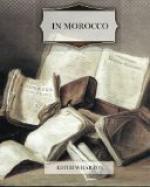[Footnote A: The Moroccans being very poor seamen, these corsair-vessels were usually commanded and manned by Christian renegadoes and Turks.]
[Footnote B: Cochelet was wrecked on the coast near Agadir early in the nineteenth century and was taken with his fellow-travellers overland to El-Ksar and Tangier, enduring terrible hardships by the way.]
With the advent of the Cherifian dynasties, which coincided with this religious reform, and was in fact brought about by it, Morocco became a closed country, as fiercely guarded as Japan against European penetration. Cut off from civilizing influences, the Moslems isolated themselves in a lonely fanaticism, far more racial than religious, and the history of the country from the fall of the Merinids till the French annexation is mainly a dull tale of tribal warfare.
The religious movement of the sixteenth century was led and fed by zealots from the Sahara. One of them took possession of Rabat and Azemmour, and preached the Holy War; other “feudal fiefs” (as M. Augustin Bernard has well called them) were founded at Tameslout, Ilegh, Tamgrout: the tombs of the marabouts who led these revolts are scattered all along the west coast, and are still objects of popular veneration. The unorthodox saint worship which marks Moroccan Moslemism, and is commemorated by the countless white koubbas throughout the country, grew up chiefly at the time of the religious revival under the Saadian dynasty, and almost all the “Moulays” and “Sidis” venerated between Tangier and the Atlas were warrior monks who issued forth from their fortified Zaouias to drive the Christians out of Africa.
The Saadians were probably rather embarrassed by these fanatics, whom they found useful to oppose to the Merinids, but troublesome where their own plans were concerned. They were ambitious and luxury-loving princes, who invaded the wealthy kingdom of the Soudan, conquered the Sultan of Timbuctoo, and came back laden with slaves and gold to embellish Marrakech and spend their treasure in the usual demoralizing orgies. Their exquisite tombs at Marrakech commemorate in courtly language the superhuman virtues of a series of rulers whose debaucheries and vices were usually cut short by assassination. Finally another austere and fanatical mountain tribe surged down on them, wiped them out, and ruled in their stead.
VII
THE HASSANIANS
The new rulers came from the Tafilelt, which has always been a troublesome corner of Morocco. The first two Hassanian Sultans were the usual tribal chiefs bent on taking advantage of Saadian misrule to loot and conquer. But the third was the great Moulay-Ismael, the tale of whose long and triumphant rule (1672 to 1727) has already been told in the chapter on Meknez. This savage and enlightened old man once more drew order out of anarchy, and left, when he died, an organized and administered empire, as well as a progeny of seven hundred sons and unnumbered daughters.[A]




